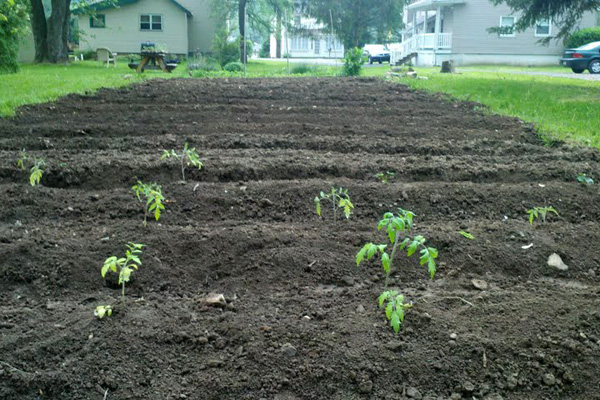-

Erin Donahue -

Christina Barkanic -

Brittany Trott -

Emily Wiley -

Jessica Reilley -

Chris Raines -

Will Nichols -

Emily Reddy -

Michele Marchetti -

Michele Frank -

James Gherardi -

Kit Henshaw -

Christina and Erin -

Kim Tait -

Erin McKinney -

Steve Spanelli -

Sam Komlenic -

Katherine Taylor Grofic -

James Eisenstein -

Jamie Oberdick -

Anna Lombardo -

LacCreta Holland -

Tony Ricci -

Local Food Journey -

Laura Young -

Kristin Camplese -

Harrison's Fresh + Local -

Danielle Matalonis -

Kristine A. -

Linda Weaver -

Naomi Elle Schwartz -

Dana Stuchul -

Cara McShane -

Brittany Smith -

Jessica Illuzzi - Frosty
-

Jessica Paholsky -

James Sechrengost -

Brad Yeckley -

Maya Althouse -

Jordan Reabold -

Kim Chase -

Maria Bryant - Alexandrea Scott
How to Transplant Tomatoes Now for Great Harvests Later
Posted by Jamie Oberdick on 05/23, 2012 at 08:42 AM

Freshly transplanted tomato plants. Photo Credit Jamie Oberdick.
It’s mid-May, which is peak time for “putting in the garden,” an old saying that means planting your frost-sensitive plants now that we are mostly past the risk of frost. (Although not completely, more on that later.)
Whether you started tomatoes from seed or bought the plants at your favorite garden center or farmer’s market, transplanting them the right way is very important.
Step one is both simple and confusing—be certain the soil temperature is at least 65 degrees. The old farmer’s trick is to drop your drawers and sit on the soil. If you can do so comfortably, then you can plant. A better method—one that will get you in much less trouble with your neighbors, spouse, and/or police—is buying a soil thermometer. You can find these at a garden center. Simply stick it in the ground to get a reading.
Why wait until the soil temperature is that high? Because the tomato plants won’t grow if the soil temperature is too cool, and you run the risk of the roots contracting disease. Plus, by early July you won’t be able to tell the difference between a plant transplanted in early May and one transplanted in late May. If you must get the plant in early, it’s a good idea to use black plastic mulch to warm the soil.
Now that the soil is at a good temperature for growing, you need to ensure that the plants are “hardened off,” which means setting them outside for around a week or so. This gets the plants used to direct sun, wind, rain, etc. Makes for a stronger plant.
Once you do this, then it’s time to plant. Many people plant the tomatoes like any other plant, but there’s a trick that ensures a faster-growing, healthier plant: dig a hole deep in your fertilized soil, enough to bury the plant about two-thirds up the stem. It’s fine if only the top leaves are exposed. The buried part of the tomato will spring roots, creating a stronger base and a healthier plant.
Now it’s time to water. Give them a good shot of water, about a gallon or so. This is to avoid transplant shock. If the plants look like they are wilting the next day, give them a bit more water. Generally, the plants recover from transplant shock and roar ahead. You will be surprised how fast they grow.
This is a personal preference and not a scientific method, but I like to give tomatoes a shot of foliar fertilizer. If you are non-organic, this would mean Miracle Gro or some other liquid. If you are like me and go organic, I hit them with a shot of diluted fish emulsion. Tomatoes seem to love it.
Once you get the plants in, you are well on your way to a great harvest. Just think ... by July you will begin to have fresh tomatoes—maybe even enough to share with friends!
![]() Author: Jamie Oberdick
Author: Jamie Oberdick
Bio: Editor, Local Food Journey | Passionate about supporting local food in Central PA
- Our Local Food Journey comes to an end
- Winter isn’t a quiet time at the farm
- Get the taste of garden season right now by growing herbs indoors
- All you need to know about PASA’s Farming for the Future conference









NO COMMENTS